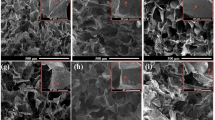Abstract
A novel composite scaffold based on chitosan-collagen/organomontmorillonite (CS-COL/OMMT) was prepared to improve swelling ratio, biodegradation ratio, biomineralization and mechanical properties for use in tissue engineering applications. In order to expend the basal spacing, montmorillonite (MMT) was modified with sodium dodecyl sulfate (SDS) and was characterized by XRD, TGA and FTIR. The results indicated that the anionic surfactants entered into interlayer of MMT and the basal spacing of MMT was expanded to 3.85 nm. The prepared composite scaffolds were characterized by FTIR, XRD and SEM. The swelling ratio, biodegradation ratio and mechanical properties of composite scaffolds were also studied. The results demonstrated that the scaffold decreased swelling ratio, degradation ratio and improved mechanical and biomineralization properties because of OMMT.
Similar content being viewed by others
References
Williams D F. The Williams Dictionary of Biomaterials. Liverpool, UK: University Press, 1999
Peter M, Ganesh N, Selvamurugan N, et al. Preparation and characterization of chitosan gelatin/nanohydroxyapatite composite scaffolds for tissue engineering applications. Carbohydrate Polymers, 2010, 80(3): 687–694
Brandi J, Ximenes J C, Ferreira M, et al. Gelcasting of aluminachitosan beads. Ceramics International, 2012, 37: 571–579
Jayakumar R, Menon D, Manzoor K, et al. Biomedical applications of chitin and chitosan based nanomaterials–a short review. Carbohydrate Polymers, 2010, 82(2): 227–232
Dong Y, Feng S S. Poly (D,L-lactide-co-glycolide)/MMT nanoparticles for oral delivery of anticancer drugs release system. Applied Clay Science, 2007, 36: 297–301
Zheng J P, Wang C Z, Wang X X, et al. Preparation of biomimetic three-dimensional gelatin/montmorillonite-chitosan scaffold for tissue engineering. Reactive & Functional Polymers, 2007, 67(9): 780–788
Gieseking J E. The mechanism of cation exchange in the montmorillonite-beidellite-nontronite type of clay minerals. Soil Science, 1939, 47(1): 1–14
Kokubo T, Takadama H. How useful is SBF in predicting in vivo bone bioactivity? Biomaterials, 2006, 27(15): 2907–2915
Olad A, Azhar F F. The synergetic effect of bioactive ceramic and nanoclay on the properties of chitosan-gelatin/nanohydroxypatitemontmorillonite scaffold for bone tissue engineering. Ceramics International, 2014, 40(7): 10061–10072
Zhang Z, Liao L, Xia Z. Ultrasound-assisted preparation and characterization of anionic surfacant modified montmorillonites. Applied Clay Science, 2010, 50(4): 576–581
Sahoo R, Sahoo S, Nayak P L. Synthesis and characterization of polycaprolactone-gelatin nanocomposites for control release anticancer drug paclitaxel. European Journal of Scientific Research, 2011, 48: 527–537
Bin Ahmad M, Lim J J, Shameli K, et al. Synthesis of silver nanoparticles in chitosan, gelatin and chitosan/gelatin bionanocomposites by a chemical reducing agent and their characterization. Molecules, 2011, 16(12): 7237–7248
Zhuang G, Zhang Z, Guo J, et al. A new ball milling method to produce organo-montmorillonite from anionic and nonionic surfactants. Applied Clay Science, 2015, 104: 18–26
Poon L, Wilson L D, Headley J V. Chitosan-glutaraldehyde copolymers and their sorption properties. Carbohydrate Polymers, 2014, 109: 92–101
Freyman T M, Yannas I V, Gibson L J. Cellular materials as porous scaffolds for tissue engineering. Progress in Materials Science, 2001, 46(3–4): 273–282
Lee J H, Park T G, Park H S, et al. Thermal and mechanical characteristics of poly(L-lactic acid) nanocomposite scaffold. Biomaterials, 2003, 24(16): 2773–2778
Marques A P, Reis R L. Hydroxyapatite reinforcement of different starch-based polymers affects osteoblast-like cells adhesion/spreading and proliferation. Materials Science and Engineering C, 2005, 25(2): 215–229
Ehrlich H, Krajewska B, Hanke T, et al. Chitosan membrane as a template for hydroxyapatite crystal growth in a model dual membrane diffusion system. Journal of Membrane Science, 2006, 273(1–2): 124–128
Chesnutt B M, Yuan Y, Brahmandam N, et al. Characterization of biomimetic calcium phosphate on phosphorylated chitosan films. Journal of Biomedical Materials Research Part A, 2007, 82(2): 343–353
Author information
Authors and Affiliations
Corresponding author
Rights and permissions
About this article
Cite this article
Cao, X., Wang, J., Liu, M. et al. Chitosan-collagen/organomontmorillonite scaffold for bone tissue engineering. Front. Mater. Sci. 9, 405–412 (2015). https://doi.org/10.1007/s11706-015-0317-5
Received:
Accepted:
Published:
Issue Date:
DOI: https://doi.org/10.1007/s11706-015-0317-5




